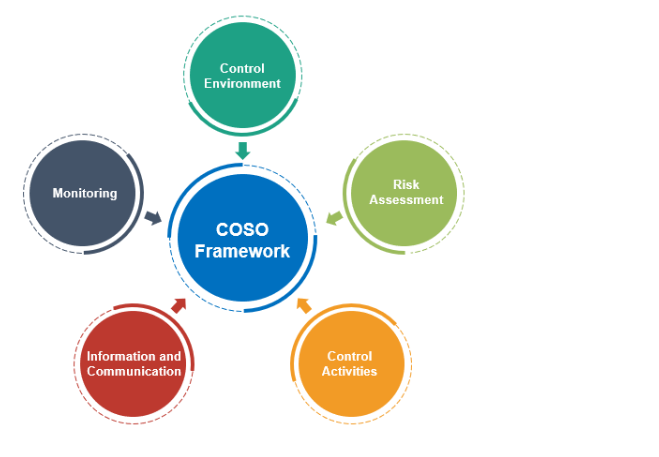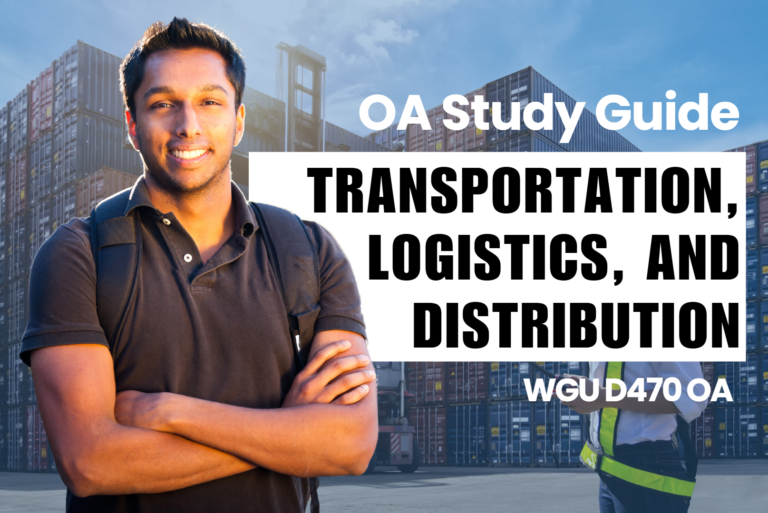WGU D215 OA Study Guide - 2025 | Materiality, the Risk Assessment Formula, and the COSO Framework 📖
Some people may think that auditing is a very boring subject, but that is not quite true because auditing takes more investigation such as detective but with the help of computers. You are still solving puzzles, finding hidden hints, observing, calculating, and so on. This article explores key concepts in risk assessment and internal control frameworks:
- Materiality and the Risk Assessment Formula: Materiality determines the significance of financial information, while the Risk Assessment Formula (Risk = Likelihood × Impact) helps organizations evaluate potential threats and their consequences.
- COSO Framework: The COSO Framework provides a structured approach to internal control, focusing on control environment, risk assessment, control activities, information & communication, and monitoring to enhance financial reporting and organizational governance.
Whether you’re trying to figure out if a missing comma in a million-dollar report matters (spoiler: when you need to estimate the risk that some large error would escape detection (it probably doesn’t), measure the probability of an error in a particular arithmetic calculation are involved, or appraise an organization’s internal control, these concepts are here to the rescue!). Overcoming them is not limited to preparing for the WGU D215 OA questions (which is always pleasant); it is about becoming the superhero of accuracy and efficiency in the preparation of financial reports.
Ready to dive in? Read on, and discover how materiality, the ‘Risk Assessment Formula’, and the COSO Framework can turn you into the auditing Sherlock Holmes – without the hat.
How to Use This Guide for the WGU D215 OA Exam?📖
The D215 Auditing OA exam at WGU evaluates your understanding of audit principles, risk assessment, and internal control frameworks. This guide simplifies the key concepts of materiality and the risk assessment formula and the COSO framework to help you grasp the topics tested in the exam.
We also provide exam-style questions and practical applications to ensure you’re fully prepared for the questions on the WGU D215 OA exam.

Materiality and the Risk Assessment Formula: A Simplified Guide For D215 OA📝
Many individuals would probably think auditing a complicated discipline, however, the basic definition of this subject implies checking financial statements to reflect a company’s circumstances. Two important concepts in auditing include Materiality and the Risk Assessment Formula. They can be divided into steps so that each person would be easy to comprehend.
What is Materiality?
Materiality is like a magnifying glass for auditors. It helps them identify what truly matters in financial statements while setting aside smaller, less significant errors. Think of it this way: if you’re reviewing your friend’s homework, a missing period at the end of a sentence might not matter much. But if an entire paragraph is missing, it’s a major issue that could change the entire meaning. Similarly, in auditing, materiality ensures that only errors or omissions significant enough to influence stakeholders’ decisions are flagged. This focus allows auditors to allocate their attention and resources effectively.
Why Does Materiality Matter?
Materiality assists auditors in identifying which mistakes or missing information in financial reports might influence investors, creditors, or other users. It is actually a question of defining what matters.
Quantitative vs. Qualitative Factors
There are two ways to figure out materiality:
- Quantitative Factors: These are numbers-based and rely on measurable criteria. For example:
- If a company’s total revenue is $1 million, an error of $50,000 (5% of revenue) might be considered material because it could affect stakeholders’ decisions.
- If an error exceeds a set percentage of net income or total assets, it’s flagged as material.
- If a company’s total revenue is $1 million, an error of $50,000 (5% of revenue) might be considered material because it could affect stakeholders’ decisions.
- Qualitative Factors: These focus on the nature or context of the item rather than its size. For example:
- If an error involves fraud, it’s always considered material, even if the amount is small, because it undermines trust.
- Misstatements that impact regulatory compliance, such as failure to disclose key financial obligations, are material because they could lead to legal consequences.
- Errors that significantly alter trends or financial ratios can mislead users and are therefore considered material regardless of their monetary value.
- If an error involves fraud, it’s always considered material, even if the amount is small, because it undermines trust.
Materiality Thresholds
A threshold is a boundary. Auditors set thresholds to decide when an error is big enough to matter. These thresholds can be based on things like a percentage of total assets or net income. They’re not the same for every company—a small business and a large corporation might have very different thresholds.
The Risk Assessment Formula
As promised, in this post we will learn about the Risk Assessment Formula Once we are done with materiality. This is like a guide that enables the auditors to go through the process of audit whilst avoiding areas that may lead to an audit issue.
What is Audit Risk?
Audit risk is the chance that an auditor gives a thumbs-up to financial statements that actually have big mistakes. Auditors use the Audit Risk Model to manage this.
Components of Audit Risk
The formula for audit risk is:
Audit Risk = Inherent Risk × Control Risk × Detection Risk
Let’s break it down:
- Inherent Risk (IR): This is the probability of an error occurring on account of the type of business or the conditions that prevail in it. For example, the business operations of a tech company can be complex, classifying the company into a high inherent risk.
- Control Risk (CR): This is the chance that the company’s internal controls (like checks and balances) won’t catch the mistake.
- Detection Risk (DR): This is the likelihood that even the auditor of the company will not detect the error by his/her own procedures.
Example Calculation
Let’s say an auditor is assessing a company with the following risks:
- Inherent Risk (IR): 0.6 (60%)
- Control Risk (CR): 0.5 (50%)
- Detection Risk (DR): 0.4 (40%)
Using the formula:
Audit Risk = IR × CR × DR
Audit Risk = 0.6 × 0.5 × 0.4 = 0.12 (12%)
This means that the probability of the auditor not being able to identify a material misstatement stands at 12 percent. To minimize this risk, the auditor may conduct more extensive procedures, and or engage in other tests.
How Auditors Use the Formula
Auditors assess each type of risk to figure out the overall audit risk. If one type of risk is high, they’ll adjust their work to compensate. For example, if a company has weak internal controls (high control risk), auditors might do extra testing to reduce detection risk.
The Relationship Between Materiality and Audit Risk
Materiality and audit risk go hand in hand. Here’s how they connect:
- Impact on Audit Strategy: Materiality levels influence how much testing auditors do. For higher risks, they’ll dig deeper.
- Reasonable Assurance: An auditor’s goal is to exercise reasonable assurance that a company’s financial records are free of material misstatements. This means that they are sure there are no material mistakes yet they are not assuring them of no mistakes at all.
Real-Life Examples
Let’s bring these concepts to life with an example:
Imagine a bakery chain with 20 stores. If the auditor finds that one store forgot to record a $10 pastry sale, it’s not material. But if the chain forgot to report revenue from an entire store, that’s material because it could mislead stakeholders.
Similarly, if the bakery’s inventory system is prone to errors (high control risk), the auditor might perform extra checks to ensure accuracy.
Importance For D215 OA
Understanding materiality and the risk assessment formula is crucial for auditors. These tools help them focus on what matters most and provide confidence in financial reporting. As students preparing for WGU D215, mastering these concepts will set you up for success in both your coursework and future audits.
Remember, these are the building blocks of auditing. Keep practicing, and don’t hesitate to dive deeper into resources like flashcards or discussion forums to strengthen your understanding.
By learning these principles, you’re not just preparing for the WGU D215 OA questions but also gaining valuable skills for a career in auditing.
Understanding the COSO Framework: A Guide For D215 OA📝
COSO framework stands as one of the basic foundations for audit and internal control processes. This concept has been developed by the Committee of Sponsoring Organizations of the Treadway Commission by offering organizations a structure that enables them to assess internal controls and ways of making them more effective. It is time to dissect its elements and ideas one by one.
What is the COSO Framework?
The COSO Framework is an ideal tool, which was developed comprehensively to assist any organization in developing, implementing, as well as assessing those internal control systems. It makes certain that activities performed are in harmony with an organization’s objectives. Developed by the Committee of Sponsoring Organizations of the Treadway Commission, the framework addresses three essential objectives foundational to success:
- Operational Effectiveness and Efficiency: This objective addresses the extent to which existing and proposed processes for delivering business operations within an organization are optimized for efficiency and efficacy. It targets at minimization of these costs which in this case are the wastes that are being incurred in the organization and the release of resources that are not maximally utilized in an effort to achieve these set objectives.
- Reliable Financial Reporting: Maintaining a proper account of financial statements and their presentation in accordance with the standard. Such information is important to stakeholders including investors, creditors, and even regulators as they use the same to arrive at decisions. Outright falsehoods which can be premeditated or inadvertent are expensive and damaging to an organization’s image.
- Compliance with Laws and Regulations: This objective ensures that the organization adheres to laws and regulations to avoid penalties and maintain its reputation. It involves staying informed about legal standards, following industry regulations, and implementing appropriate policies. Non-compliance can lead to fines, legal actions, or operational setbacks, making this an essential focus for sustainable success.
This framework provides reasonable assurance that these objectives can be achieved by implementing strong internal controls.
The Five Components of the COSO Framework

The COSO Framework consists of five interrelated components, each playing a crucial role in maintaining effective internal controls:
1. Control Environment
This is the foundation of the entire framework. It creates the organizational culture that influences how employees understand and implement internal controls. Key elements include:
- Integrity and Ethical Values: Promoting a culture of honesty, transparency, and ethical behavior through a clear code of conduct.
- Commitment to Competence: Ensuring that employees are equipped with the necessary skills and knowledge to perform their duties effectively, including regular training programs.
- Organizational Structure: Authorizing the delegation of responsibilities, and avoiding overlapping, confusion, and communication mix-up.
- Management Philosophy and Operating Style: Implementing management controls as part of an organization’s governance framework will bring into focus issues to do with risk and ethical practice.
- Human Resource Practices: These include employment procedures, initial training, and assessment consistent with organizational culture, and achievement of corporate vision and mission.
With regards to definition, a control environment is a system within the organization that enables individuals within the organization to appreciate the role they have in ensuring that the internal control system in the company is in place.
2. Risk Assessment
This component focuses on understanding and managing risks that might hinder the organization from meeting its goals. The steps involved are:
- Setting Clear Objectives: Defining organizational goals and expectations, which provide a framework for identifying and assessing risks.
- Identifying Risks: Identifying internal risks, such as poor working processes, and staff mistakes; and external risks, such as fluctuations in market demand or shifts in legislation affecting the company’s mission.
- Analyzing Risks: Assessing the possibility of risks taking place, and the consequences they are likely to have. This analysis is beneficial in risk ranking, risk control decisions, and risk treatment considerations.
- Developing Risk Responses: Developing tactics to counter more effectively the heedless risks that have been pinpointed, including bearing the risk, rejecting it, minimizing it, or transferring it through insurance or joint ventures.
That is why risks may be viewed as factors, which can be analyzed by an organization in order to create the best approach to controlling them.
3. Control Activities
Control activities are the specific actions taken to minimize risks and ensure management’s directives are executed effectively. They include:
- Approvals and Authorizations: Reviewing and approving transactions or processes to confirm their validity before execution.
- Verifications: Checking the accuracy and completeness of data through reconciliations and cross-checks.
- Segregation of Duties: Distributing responsibilities among different individuals to reduce the risk of errors or fraud.
- Physical Controls: Preserving assets by use of aspects like locks, limited access, and night security cameras.
- IT Controls: The use of controls in information systems that are based on software which include the use of user identification and data encryption.
- These activities provide certain restraints in a bid to minimize mistakes or even fraud.
These activities serve as checks and balances to reduce the risk of errors and fraud.
4. Information and Communication
This component ensures that relevant information is identified, captured, and communicated effectively within the organization. It includes:
- Timely and Relevant Information: Providing accurate, complete, and up-to-date information to decision-makers to facilitate effective management and control.
- Internal Communication: Ensuring clear and efficient communication channels between departments, teams, and individuals to support coordination and understanding.
- External Communication: Reporting to the users of this information such as investors, regulators, and customers in order to build their trust in the business.
- Use of Technology: Utilizing enhanced systems in the flow of information that is gathered and delivered to and from the organization.
Good communication ensures everyone understands their role in maintaining internal controls.
5. Monitoring Activities
Monitoring ensures that internal controls are consistently effective and adapt to changes over time. Key practices include:
- Ongoing Monitoring: Functional, continual touchpoint check, elements of governance to assert that issues or risks are discovered during normal business.
- Separate Evaluations: Change the focus of the assessments from one of achieving specific control objectives to periodic, independent review or audit to assess the adequacy of the controls already in place.
- Reporting Deficiencies: The timely reporting of control weaknesses or control failures to management and other concerned persons.
- Follow-Up Actions: Ensuring that identified issues are addressed and resolved promptly to maintain the integrity of internal controls.
Monitoring ensures that controls adapt to changing conditions and remain robust.
How Auditors Use the COSO Framework
Auditors rely on the COSO Framework to evaluate and strengthen an organization’s internal controls. This framework acts as a benchmark to ensure processes align with organizational objectives and comply with relevant standards. Here’s a detailed look at how auditors utilize the framework:
- Assessing Design and Implementation: Auditors begin by reviewing the organization’s internal control design. They assess whether the controls align with the organization’s operational, reporting, and compliance goals. For instance, they evaluate whether policies such as segregation of duties are effectively structured to prevent fraud.
- Evaluating Effectiveness: The next step in the process of the assessment of the control is to evaluate their effectiveness in their operation. Some of the activities carried out by auditors include walkthroughs, physical inspections, and tests of samples in order to assure the representatives of the organization regarding the reliability of the control environment, managing risks, and control activities.
- Identifying Gaps and Weaknesses: During their evaluation, auditors identify areas where controls are insufficient or absent. This might include ineffective monitoring activities or a lack of timely communication within the organization.
- Providing Recommendations: After identifying gaps, auditors suggest practical and actionable improvements. These recommendations aim to enhance internal controls and address weaknesses. For example, an auditor may advise implementing stronger IT security measures or conducting more frequent monitoring activities.
- Tailoring Audit Plans: Auditors apply the common components of the COSO Framework and draw upon them to better inform their audit strategies. For instance, if the risk assessment shows that inherent risk is high in some particular area, auditors might assign more time for exploring this area than it would usually take.
- Benchmarking Against Standards: The COSO Framework can thus be said to serve a function of giving a structure that makes sure that auditors’ assessments fit the most trusted formats across the world. This continuity is most crucial when it comes to regulatory audits, as well as issues touching on financial reporting.
As a result, using the COSO Framework, auditors can offer clear recommendations to help organizations understand the state of their internal control effectively, reliability, and compliance with the standards.
For instance, while conducting a financial audit, the auditors may assess the level of compliance of an entity with the organization’s ethical control environment on financial reporting.
Real-Life Example
Imagine a retail company implementing the COSO Framework. The company:
- Establishes a code of ethics (Control Environment).
- Identifies risks like theft or data breaches (Risk Assessment).
- Implements security cameras and password-protected systems (Control Activities).
- Ensures regular communication about security policies (Information and Communication).
- Conducts monthly reviews of sales records (Monitoring Activities).
By following these steps, the company minimizes risks and ensures smooth operations.
Importance For D215 OA
The COSO Framework is an important enabler when it comes to having good internal controls. With the knowledge of its five parts in mind, it is easier for organizations to run effectively, report their financials correctly, and meet the laid-down laws and regulations.
Mastering the COSO Framework helps WGU D215 OA questions students understand and learn more about actual auditing experiences in preparing for the questions. Continually search and apply these concepts in your coursework and any further audits to do well.
Tired of reading blog articles?
Let’s Watch Our Free WGU D215 Practice Questions Video Below!

Wrapping Up: Ace Your WGU D215 OA with Confidence📖
These concepts not only play an important role in achieving reliability in financial reporting but also preserve the credibility of the organizations. Hence, by understanding these topics, you are not only likely to have answers to the WGU D215 OA questions but also a platform for beginning the auditing profession.
Of course, materiality teaches one to concentrate on what is really important in a given situation, the risk assessment formula shows one appropriate way for potential mistake identification and the COSO Framework proves that internal controls are really maximized. Combined, they help you to work through the issues involved in auditing like an expert.
Well, it’s time for you to be in charge and make a move. If you pay enough attention to these concepts and try to solve the OAs using them, then you are ready for the last fight. You’re going to do great in your journey through WGU D215—Best of Luck!






